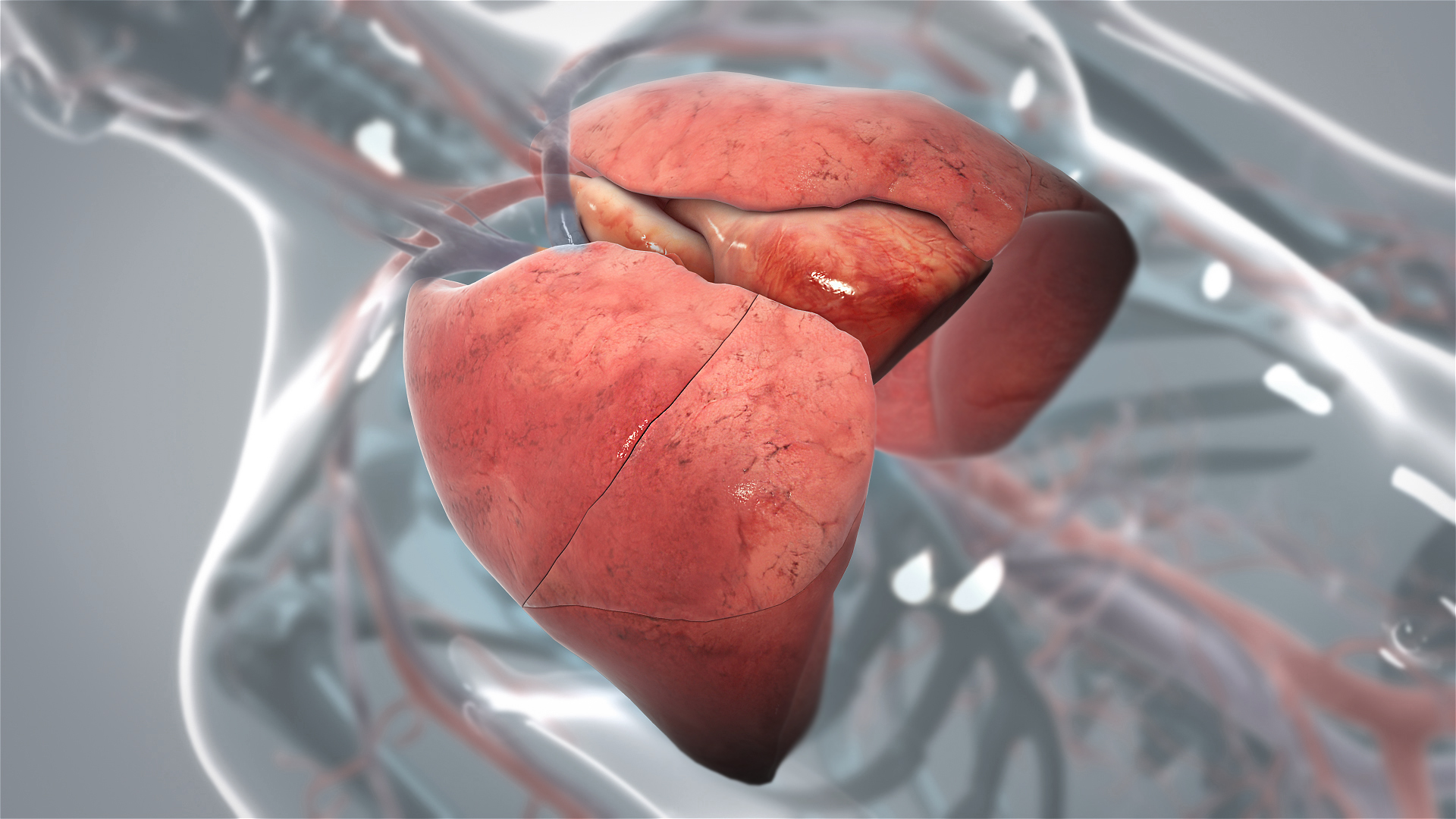
What is lung cancer?
Cancer of the lung, like all cancers, results from an abnormality in the body's basic unit of life, the cell. Normally, the body maintains a system of checks and balances on cell growth so that cells divide to produce new cells only when new cells are needed. Disruption of this system of checks and balances on cell growth results in an uncontrolled division and proliferation of cells that eventually forms a mass known as a tumor.
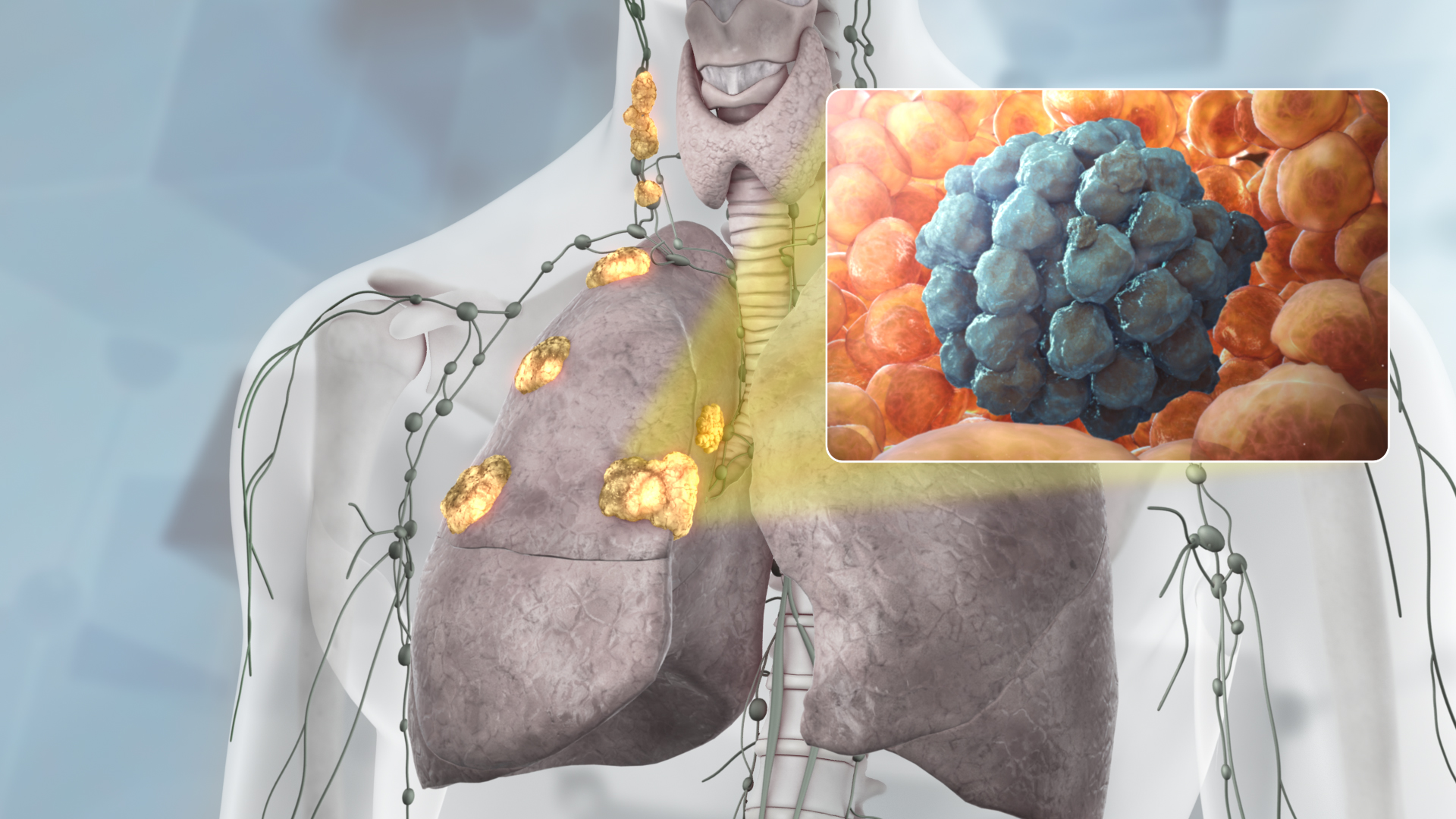
Tumors can be benign or malignant; when we speak of "cancer," we are referring to those tumors that are malignant. Benign tumors usually can be removed and do not spread to other parts of the body. Malignant tumors, on the other hand, grow aggressively and invade other tissues of the body, allowing entry of tumor cells into the bloodstream or lymphatic system and then to other sites in the body. This process of spread is termed metastasis; the areas of tumor growth at these distant sites are called metastases. Since lung cancer tends to spread or metastasize very early after it forms, it is a very life-threatening cancer and one of the most difficult cancers to treat. While lung cancer can spread to any organ in the body, certain locations -- particularly the adrenal glands, liver, brain, and bones -- are the most common sites for lung cancer metastasis.
What are the stages in lung cancer?
There are various stages of lung cancer indicating how much the cancer has spread in the body (for example, to the lymph nodes or to distant organs like the brain). Stages for non-small cell cancers are different from small cell cancers.
A Non-small-cell cancer(NSCLC) is any type of epithelial lung cancer other than small cell lung caner. As a class Non-small-cell cancer is relatively insensitive to chemotherapy, compared to small cell carcinoma.
According to the American Cancer Society, approximately 85-90 percent of lung cancer cases are NSCLC
The stages listed below are taken from the National Cancer Institute’s lung cancer staging information
The following two stages are used for small cell lung cancer:
- Limited-stage
- Extensive-stage small cell cancer.
The following stages are used for non-small cell lung cancer:
- Occult (hidden) stage
- Stage 0 (carcinoma in situ)
- Stage I
- Stage II
- Stage III A
- Stage III B
- Stage IV
What happens in Stage 3 of lung cancer?
After someone is diagnosed with stage 3 non-small cell lung cancer, people always ask is “what is stage 3 lung cancer life expectancy?” Not unexpected, since 30% of people have already progressed to stage 3 lung cancer (and 40% to stage 4) at the time they are diagnosed. Before answering the question though, it is important to talk a little about how the answer – the statistical answer – is derived.
Variables
Stage 3 lung cancer life expectancy can vary considerably among different people. Some of these variables include:
- The particular lung cancer type – Stage 3 lung cancer encompasses several lung cancer types
- The location of cancer - Stage 3 lung cancer is broken down into stage 3A lung cancer and stage 3B lung cancer, depending upon which tissues near the lungs that the cancer has spread to
- Age – Younger people tend to live longer than older people with lung cancer
- Sex – The life expectancy for woman with lung cancer is higher at each stage of lung cancer
- General health at the time of diagnosis – Being healthy overall at the time of diagnosis is associated with a longer life expectancy, and a greater ability to withstand treatments that may extend survival
- How one can respond to treatment – Side effects of treatments such as chemotherapy, targeted therapies, and radiation therapy vary among different people, and may limit the ability to tolerate treatment
- Other health conditions one may have – Health conditions such as emphysema may lower stage 3 lung cancer life expectancy
- Complications of lung cancer – Complications such as blood clots can lower lung cancer life expectancy
Statistics
In addition to variations between different people, it is important to keep in mind that statistics are frequently a few years old. For example, the most recent statistics we have for lung cancer are from 2005. With advances in treatment, statistics may not be the same as they were when newer treatments were unavailable.
That said, the median life expectancy for stage 3 non-small cell lung cancer (the time at which 50% of patients are alive and 50% have passed away) is around 15 months for stage 3A and 13 months for stage 3B. The 5-year survival rate -- that is the percent of people who are expected to be alive 5 years after a diagnosis of stage 3 lung cancer -- is sadly only 23% for stage 3A and around 10% for stage 3B.
TNM System to define stages of lung cancer
Oncologists use the TNM system to further define stages of lung cancer. A simplified description of the TNM system includes:
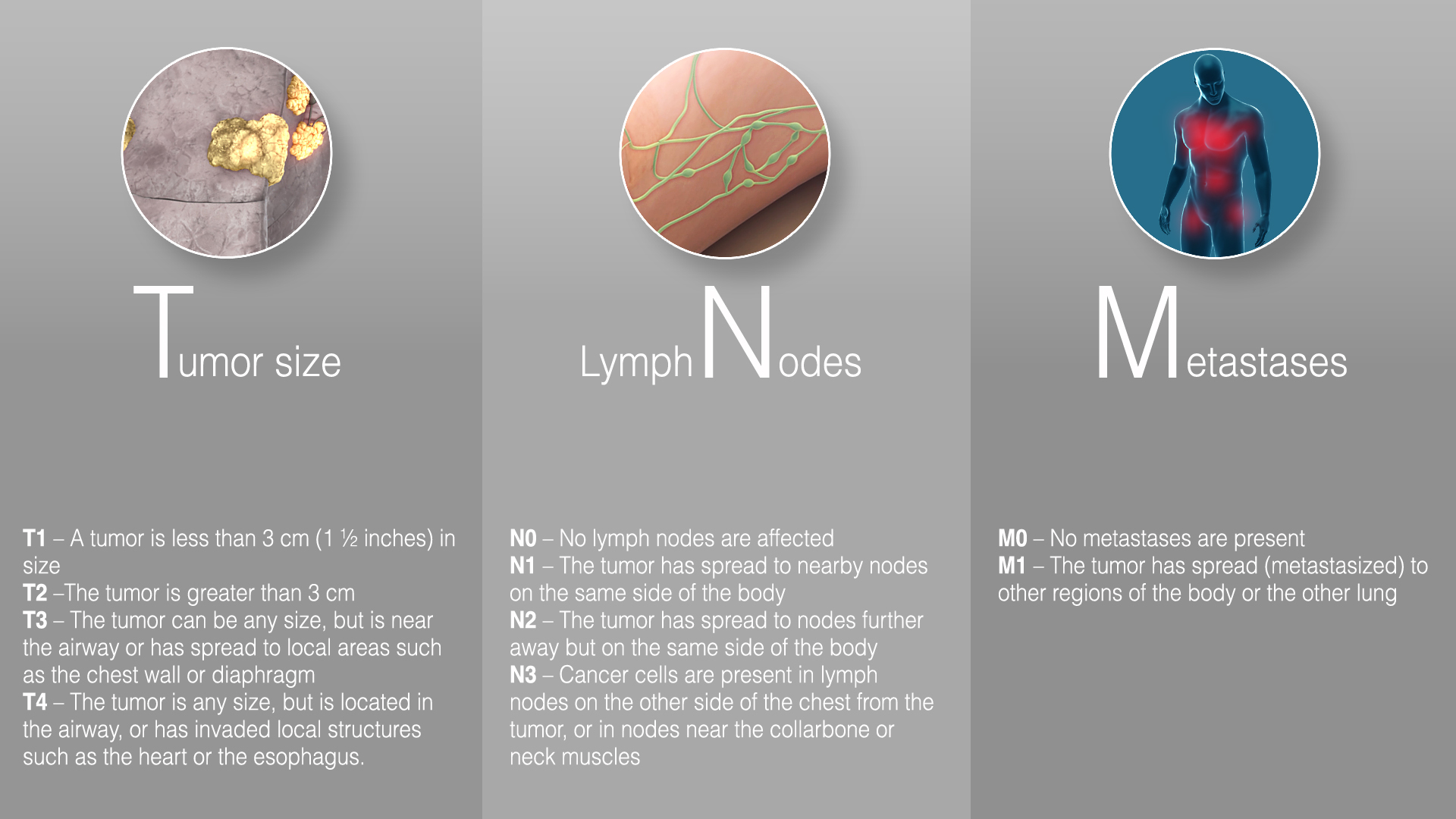
T refers to tumor size:
- T1 – A tumor is less than 3 cm (1 ½ inches) in size
- T2 –The tumor is greater than 3 cm
- T3 – The tumor can be any size, but is near the airway or has spread to local areas such as the chest wall or diaphragm
- T4 – The tumor is any size, but is located in the airway, or has invaded local structures such as the heart or the esophagus. A tumor is also considered T4 if cancer cells are present in the space between the layers lining the lungs (malignant pleural effusion).
N refers to lymph nodes:
- N0 – No lymph nodes are affected
- N1 – The tumor has spread to nearby nodes on the same side of the body
- N2 – The tumor has spread to nodes further away but on the same side of the body
- N3 – Cancer cells are present in lymph nodes on the other side of the chest from the tumor, or in nodes near the collarbone or neck muscles.
M represents metastatic disease:
- M0 – No metastases are present
- M1 – The tumor has spread (metastasized) to other regions of the body or the other lung
Stage 3A Non-Small Cell Lung Cancer
Stage 3A lung cancer includes tumors that are large and have spread to nearby lymph nodes, or tumors of any size that have spread to lymph nodes that are further away but still on the same side of the body as the cancer.
Stage 3A non-small cell lung cancer is considered a “locally advanced” cancer, meaning the tumor has not spread to distant regions of the body but has spread to lymph nodes on the same side of the body as the tumor. Roughly 10% of people have stage 3A lung cancer at the time of diagnosis, with 60% of people having more advanced stages of the disease.
Using the TNM System, Stage 3A lung cancer is described as:
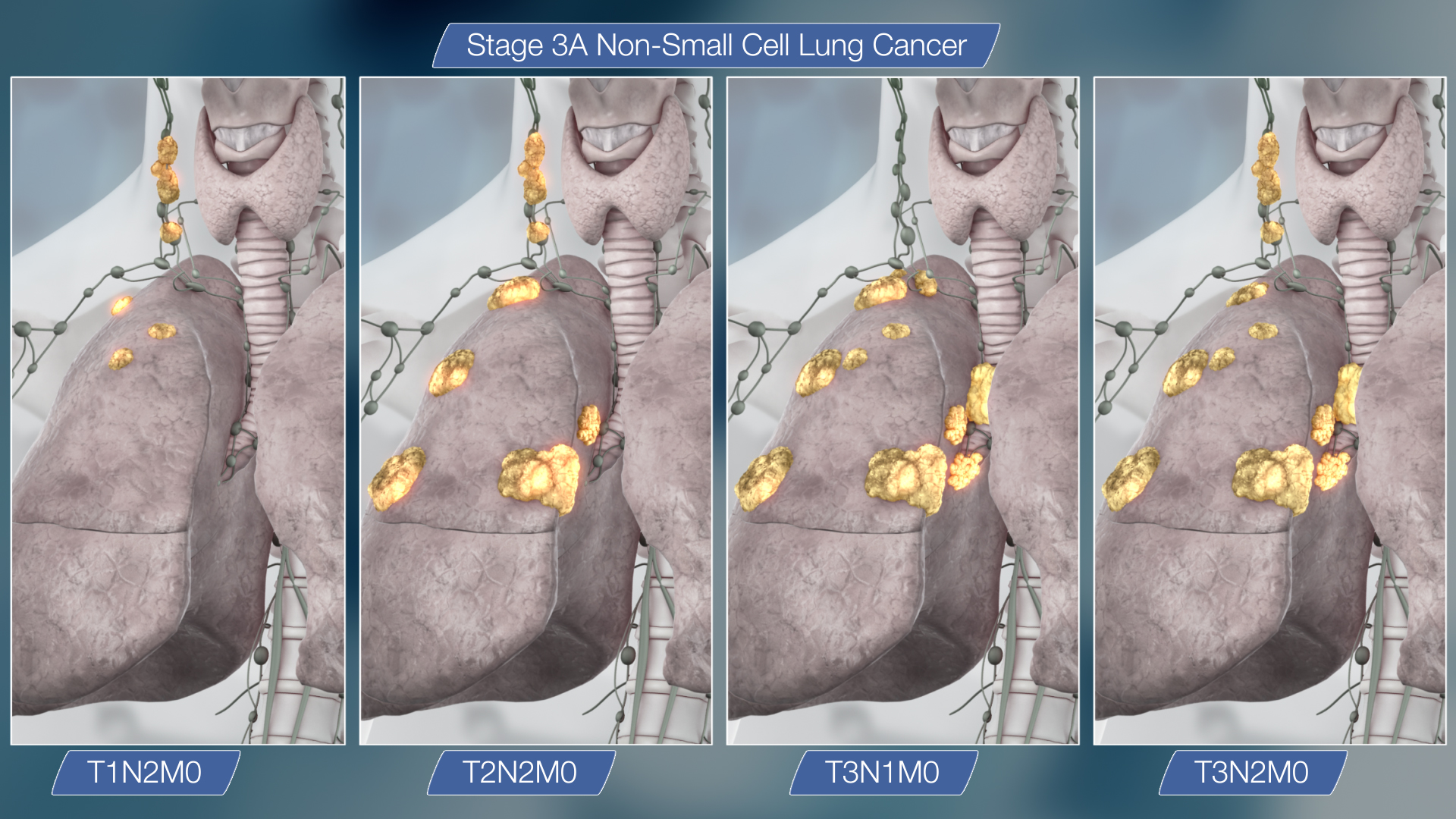
- T1N2M0 – Tumor is less than 3 cm in size and has spread to lymph nodes further away but on the same side of the body as the tumor
- T2N2M0 – The tumor is larger than 3 cm, and has spread to lymph nodes further away but on the same side of the body
- T3N1M0 – The tumor is any size but is near an airway or has spread locally to an area like the chest wall or diaphragm, and nearby lymph nodes are affected
- T3N2M0 – The tumor is any size but is near an airway or has spread locally to an area like the chest wall or diaphragm, and lymph nodes that are further away but on the same side of the body are affected
Symptoms of stage 3A lung cancer
Symptoms of stage 3A lung cancer are variable since stage 3A includes a wide spectrum of cancers. Symptoms due to cancer in the lungs such as a persistent cough, shortness of breath, and repeated infections such as pneumonia or bronchitis, are common. Spread to areas such as the chest wall and diaphragm can result in pain in the chest, ribs, shoulders, and back. Tumors located near the airways can cause hemoptysis (coughing up blood), wheezing, and hoarseness.
Treatment
The treatment of stage 3A lung cancer is the most controversial of all lung cancer stages, partly because this group is so varied. Due to the poor survival rate, the National Cancer Institute states that everyone with stage 3A lung cancer should be considered a candidate for clinical trials –- studies that are evaluate new treatments or combinations of treatments for lung cancer.
In some cases, surgery can be performed to remove the tumor, and is usually followed up with adjuvant chemotherapy (chemotherapy after surgery). Preoperative chemotherapy (chemotherapy before surgery) has been found to improve survival in a few studies. Combination chemotherapy (using a combination of chemotherapy medications) along with radiation therapy or another treatment is often used if a stage 3A lung cancer is considered inoperable because of its location, how far it has spread, or if your general health would make surgery risky. For those that are unable to tolerate surgery or chemotherapy, radiation therapy remains an option.
- Surgery
- Chemotherapy
- Radiation Therapy
- Clinical Trials
Prognosis
The overall 5-year survival rate with stage 3A lung cancer is 23%, but this varies widely among different cancers that are classified as stage 3A.
Stage 3B Non-Small Cell Lung Cancer
Stage 3B lung cancer is defined as a tumor of any size that has spread to distant lymph nodes, has invaded other structures in the chest (such as the heart or esophagus), or has a malignant pleural effusion (fluid build-up containing cancer cells between the layers lining the lungs).
Stage 3B non-small cell lung cancer is considered advanced lung cancer along with stage 4, and though it is not usually curable, it is treatable. About 20% of people have stage 3B lung cancer at the time of diagnosis, with another 40% of individuals having already progressed to stage 4.
Using the TNM System Stage 3B is described as:
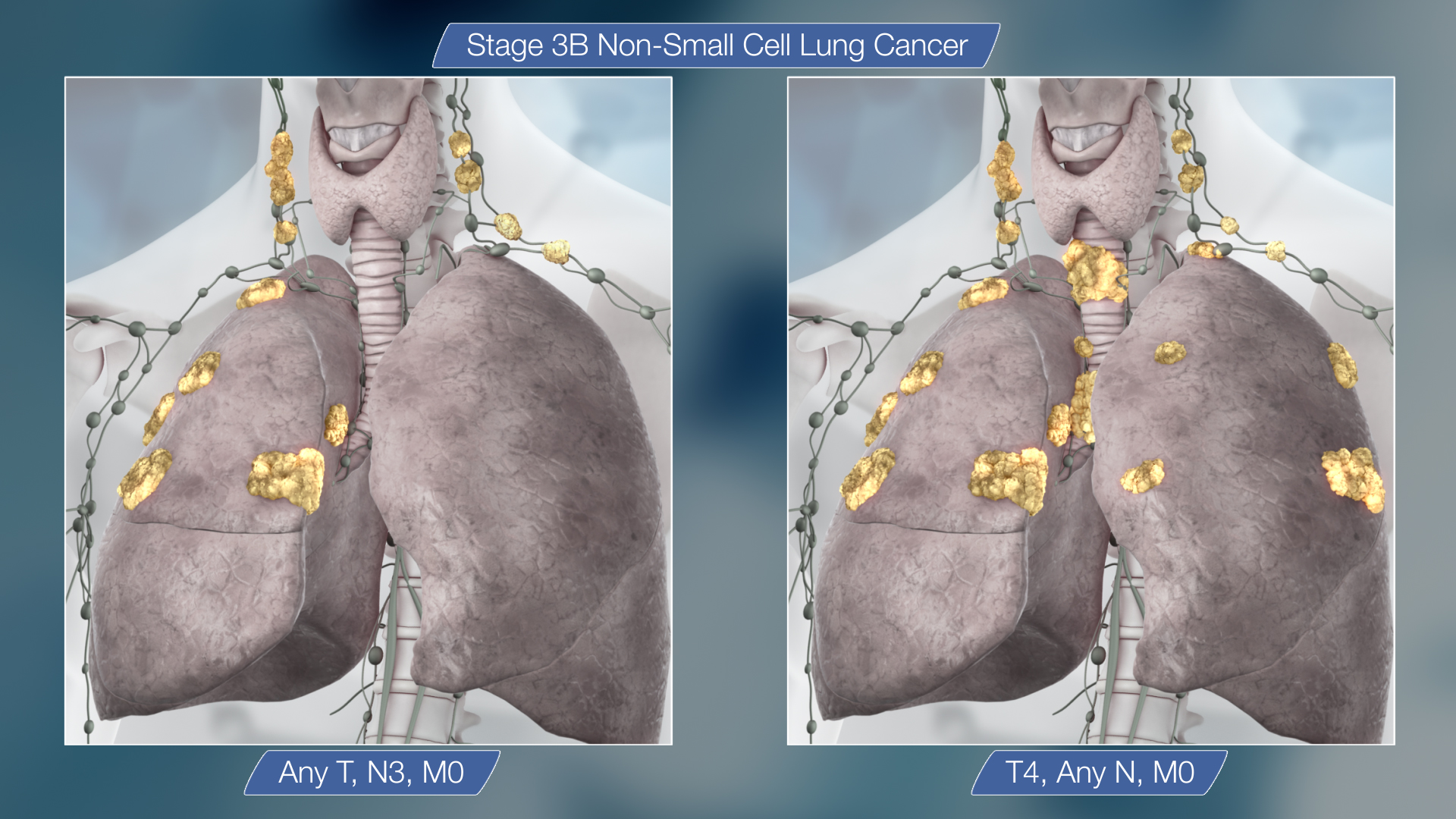
- Any T, N3, M0 – A tumor of any size that has spread to lymph nodes on the other side of the chest from the tumor or to nodes near the collarbone or neck muscles, but has not spread to distant regions of the body
- T4, Any N, M0 – A tumor of any size that is located in the airways, has invaded local structures such as the heart or esophagus, or has a malignant pleural effusion. Nodes may or may not be involved, and when affected, can be near the tumor or further away in the chest or neck, but the tumor has not spread to distant regions of the body
Symptoms
Common symptoms of Stage 3 lung cancer include a persistent cough and shortness of breath. Tumors near the airways can result in hemoptysis (coughing up blood). When the tumor involves areas such as the esophagus and other chest structures, difficulty swallowing and hoarseness can occur. Pain in the back, chest, and ribs is common if a pleural effusion is present, and this can result in increasing shortness of breath as well. General symptoms of cancer such as fatigue and unintentional weight loss may be present as well.
Treatment
With rare exceptions, stage 3B lung cancer is considered inoperable (surgery will not cure the cancer), but is not untreatable. For those that are relatively healthy, a combination of chemotherapy or chemotherapy and radiation therapy is often recommended. If individuals are unable to tolerate chemotherapy, radiation therapy can be used alone. While radiation therapy is not usually given with the intent of curing cancer, it can be helpful in treating symptoms such as pain, shortness of breath, and coughing.
To read more articles like this go to our blog page.







